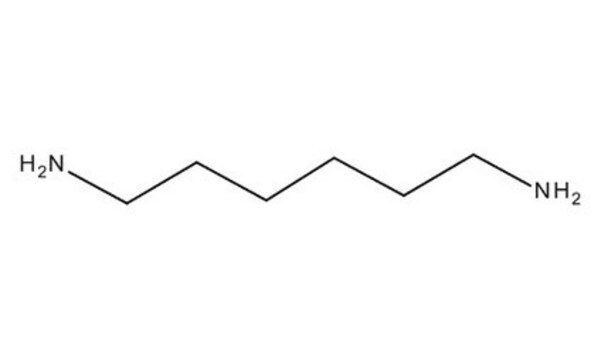15404
N-Boc-1,4-butanediamine
≥97.0% (GC/NT)
Synonym(s):
N-Boc-1,4-diaminobutane, tert-Butyl N-(4-aminobutyl)carbamate
Sign Into View Organizational & Contract Pricing
All Photos(1)
About This Item
Linear Formula:
(CH3)3COCONH(CH2)4NH2
CAS Number:
Molecular Weight:
188.27
Beilstein:
1937878
MDL number:
UNSPSC Code:
12352116
PubChem Substance ID:
NACRES:
NA.22
Recommended Products
Quality Level
Assay
≥97.0% (GC/NT)
reaction suitability
reagent type: cross-linking reagent
refractive index
n20/D 1.460
density
0.984 g/mL at 20 °C (lit.)
functional group
Boc
amine
SMILES string
NCCCCNC(OC(C)(C)C)=O
InChI
1S/C9H20N2O2/c1-9(2,3)13-8(12)11-7-5-4-6-10/h4-7,10H2,1-3H3,(H,11,12)
InChI key
ZFQWJXFJJZUVPI-UHFFFAOYSA-N
Application
- Carboxy-Silane Coated Iron Oxide Nanoparticles: Details the application of N-Boc-1,4-butanediamine in modifying iron oxide nanoparticles for imaging and drug delivery (D Stanicki, S Boutry, S Laurent, et al., 2014). Access the article.
Other Notes
Preparation of pharmacologically active compounds. Preparation of spermidine analogues. Introduction of a C4-spacer.
Signal Word
Danger
Hazard Statements
Precautionary Statements
Hazard Classifications
Skin Corr. 1B
Storage Class Code
8A - Combustible corrosive hazardous materials
WGK
WGK 3
Flash Point(F)
228.2 °F - closed cup
Flash Point(C)
109.0 °C - closed cup
Personal Protective Equipment
dust mask type N95 (US), Eyeshields, Gloves
Choose from one of the most recent versions:
Already Own This Product?
Find documentation for the products that you have recently purchased in the Document Library.
Customers Also Viewed
L I Kruse et al.
Journal of medicinal chemistry, 32(2), 409-417 (1989-02-01)
In an attempt to identify a soluble oncodazole analogue that could be easily formulated, a series of substituted oncodazoles was synthesized and evaluated for tubulin binding affinity, in vitro cytotoxicity against cultured mouse B-16 cells, and ability to prolong lifespan
Shaohui Deng et al.
Science advances, 6(29), eabb4005-eabb4005 (2020-08-25)
Controlled release of CRISPR-Cas9 ribonucleoprotein (RNP) and codelivery with other drugs remain a challenge. We demonstrate controlled release of CRISPR-Cas9 RNP and codelivery with antitumor photosensitizer chlorin e6 (Ce6) using near-infrared (NIR)- and reducing agent-responsive nanoparticles in a mouse tumor
Y Shai et al.
Biochemistry, 28(11), 4801-4806 (1989-05-30)
In the present study we synthesize 18F-labeled insulin of high specific radioactivity. A new prosthetic group methodology, in which [18F]fluoride displaces a bromide group of 4-(bromomethyl)-benzoylamine intermediates, was used. The 4-(fluoromethyl)benzoyl product was chemically stable. 18F-Labeled insulin retains the essential
Anand Divakaran et al.
Journal of medicinal chemistry, 61(20), 9316-9334 (2018-09-27)
As regulators of transcription, epigenetic proteins that interpret post-translational modifications to N-terminal histone tails are essential for maintaining cellular homeostasis. When dysregulated, "reader" proteins become drivers of disease. In the case of bromodomains, which recognize N-ε-acetylated lysine, selective inhibition of
Abshar Hasan et al.
Frontiers in chemistry, 8, 416-416 (2020-06-13)
Poly(N-substituted glycine) "peptoids" are an interesting class of peptidomimics that can resist proteolysis and mimic naturally found antimicrobial peptides (AMPs), which exhibit wide spectrum activity against bacteria. This work investigates the possibility of modifying peptoid AMP mimics (AMPMs) with aliphatic
Our team of scientists has experience in all areas of research including Life Science, Material Science, Chemical Synthesis, Chromatography, Analytical and many others.
Contact Technical Service










